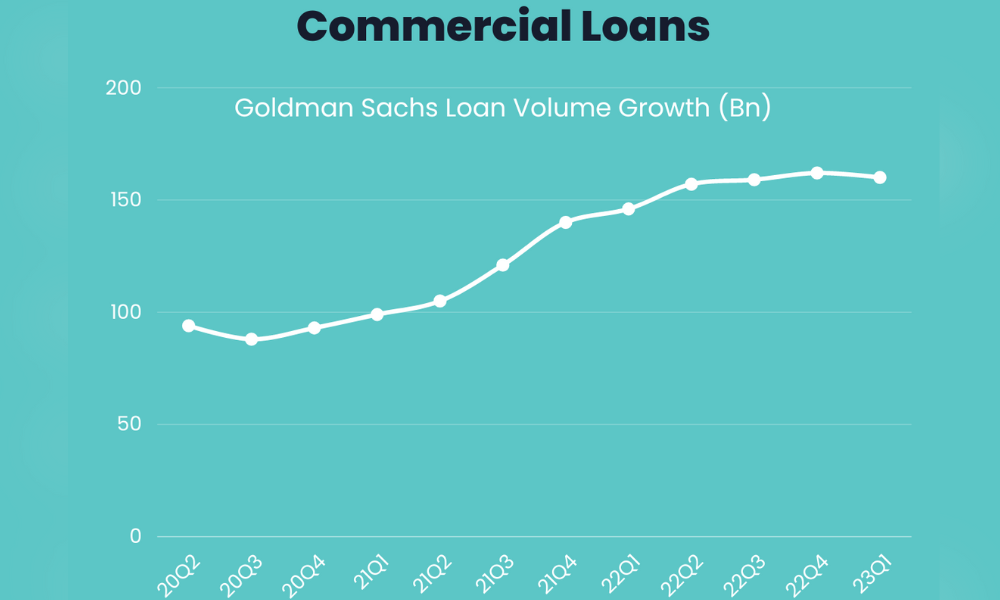What do you do when a billionaire won’t pay the mortgage?

Following the Financial Crisis, Goldman Sachs became a regulated bank and has since dedicated substantial effort to growing its lending business. A decade ago, the bank, headquartered in NY, had $3 billion in outstanding loans. Fast forward to 2023, and that number has ballooned to $180 billion.
Until recently, this approach seemed to be working well. Profits from its lending division reached a new record, hitting $3.7 billion in the first quarter of 2023. However, the bank has also witnessed an incredibly rapid growth in delinquencies of commercial real estate loans - partly influenced by Tesla’s Elon Musk. In November, after a bruising battle to avoid taking over Twitter, the billionaire started a dramatic cost-cutting exercise, including not paying rent. Columbia Property, Twitter’s landlord, is now suing, and as a result, defaulted on its loan from Goldman Sachs in February.
The San Francisco office market finds itself in a perfect storm—the epicenter of the technology industry downturn—and has been hit hard, exacerbating the work-from-home legacy of the pandemic. According to data from Cushman & Wakefield, San Francisco and Los Angeles had an average office vacancy rate of 24.8% in the first quarter. Loans for San Francisco offices now face the highest risk of default among all US metro areas, as reported by CRE data provider Trepp.
Reports filed by Goldman’s licensed banking entity with the US Federal Deposit Insurance Commission revealed that the value of loans to commercial real estate borrowers (CRE) behind on repayments increased by 612% to $840 million in Q1. In one vital aspect, Goldman is leading its peers, as the rise in delinquent CRE loans at Goldman surpassed the overall increase in delinquencies reported by the entire US banking industry, which saw a 30% rise over the same period, reaching slightly over $12 billion. These figures were collated by Bankregdata.com, which compiles the FDIC reports.
The surge in delinquencies within Goldman’s deposit-taking business coincided with other banks warning of mounting losses on commercial real estate loans, primarily associated with office buildings approved before the pandemic when working from home was not widespread.
“Banks and institutional capital are now very concerned about the office exposure they already have, so getting a new loan - even on a good office asset - is incredibly challenging,” said Miriam Wheeler, head of Goldman Sachs’ Global Real Estate Financing Group in Investment Banking, in an analysis paper last week.
“We’ve seen in the CMBS market that if you look at the conduit product - which is a product where lenders pool together loans backed by different property types, different borrowers - historically, we used to have 30% to 35% office concentrations. That’s already been reduced in recent deals to 15% to 20% based on investor demand. I think there’s going to be further downward pressure on office percentages, and so there just aren’t many available outlets to finance office right now.”
“Weakness continues to develop in commercial real estate office,” said Wells Fargo chief executive Charlie Scharf on a call with analysts recently, and that does not bode well for lenders. A Trepp study of 4,760 banks’ public regulatory data found that 763 have either a CRE or construction loan concentration ratio that exceeded the 2006 guidance from the FDIC.
Compared to its larger competitors, Goldman has significantly less exposure to commercial real estate lending. The FDIC report indicated that it held $8.4 billion of outstanding loans supported by commercial property by the end of Q1, whereas Wells Fargo had $91 billion and Bank of America had $60 billion. Nonetheless, the increasing delinquencies serve as a reminder of the challenges Goldman faces as it endeavors to diversify its business away from its traditional focus on deals and trading.
Goldman, along with Citigroup and Deutsche Bank, was part of a group of banks that provided $1.7 billion in loans to Columbia Property, a real estate investment trust. The loan was secured against seven office buildings in San Francisco and New York, two of which accommodate large Twitter offices.
The worst markets for office vacancy rates
In its latest report on the state of the office market, Cushman and Wakefield’s stats show the metro areas with the highest vacancy rates in the nation:
- Fairfield County, CT: 30.2%
- Westchester County, NY: 26.8%
- Columbus, OH: 26.7%
- Houston, TX: 26.0%
- Los Angeles CBD, CA: 25.5%
- Minneapolis/St. Paul, MN: 25.1%
- Phoenix, AZ: 25.0%
- San Francisco, CA: 24.8%



